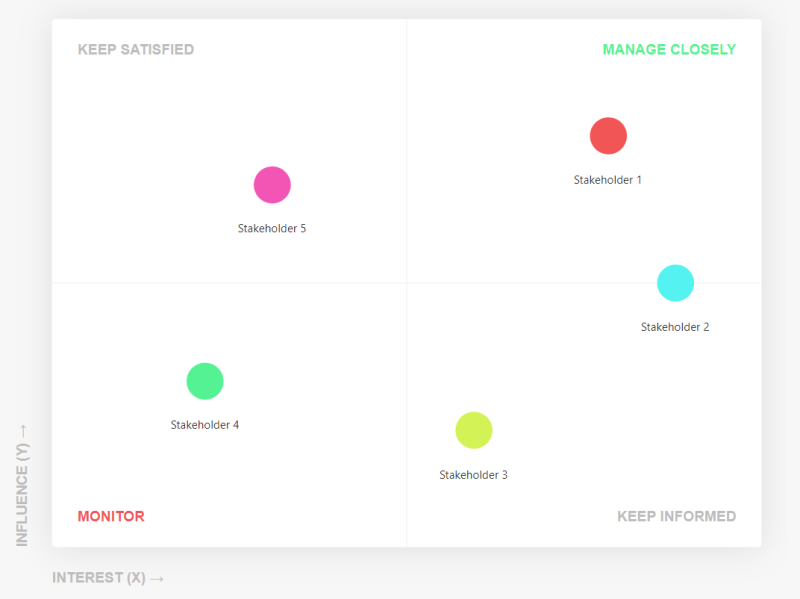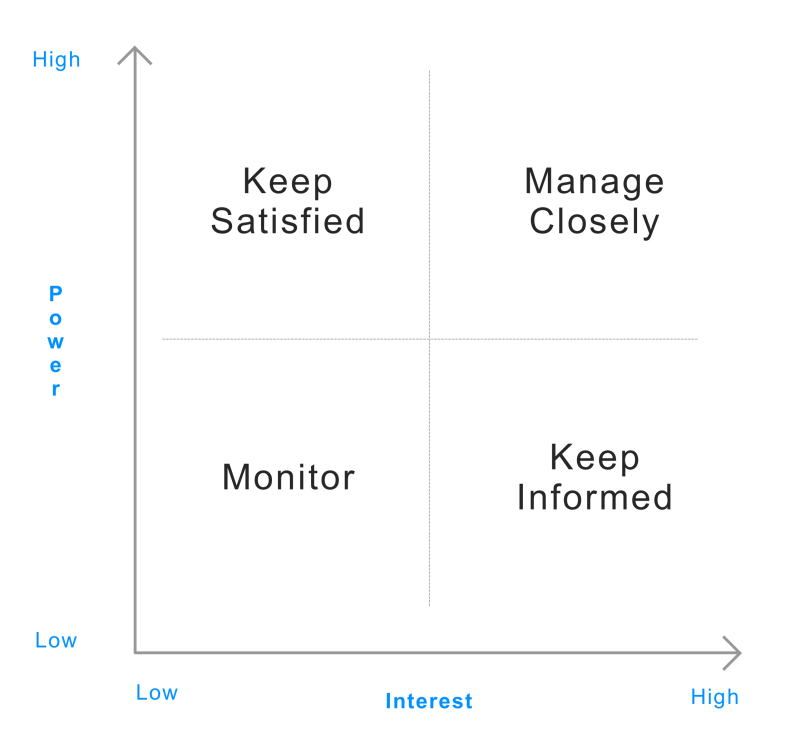
A product’s outcome – be it positive or negative – is determined by its stakeholders. Because of this, it is absolutely critical that product managers do what they can to nail stakeholder management.
But, we hear you. That’s often easier said than done.
As a product manager, you have to navigate a myriad of stakeholders to get your product off the ground, from your C-suite all the way to end-users. Unfortunately, navigating this complex interpersonal landscape can often feel like a minefield.
If you’re a product manager who is currently struggling with stakeholders, worry not. In this post, we’ll look at some key methodologies that any product manager can adopt to encourage great stakeholder engagement.
Ready? Let’s dive in…
First up, what exactly is a product stakeholder?
Put simply: a product stakeholder is anyone with a vested interest in the success of a product.
Key stakeholders include all resources who touch the product, starting from the top down. This can include:
Product sponsors, organizational leaders, and decision-makers: who are focused on the ultimate business outcome of a product
Developers: who have ownership of bringing the product to life
Designers: who are responsible for the visual communication and experience of the product
Marketing teams: who will be focused on how to communicate about the product to key audiences
Customer support: who are on the frontline and are likely to have the most in-depth user understanding on the team
Investors: who are solely focused on ROI
Your end-users: who are at the heart of everything.
As Gary Richardson says in his book, Project Management Theory and Practice: each stakeholder “holds a piece of the project success and the PM must extract that piece from each.”
Whether you can appreciate it at the early stages of the project or not, every stakeholder will have a huge influence on the shape of your end product. Their input is invaluable, and they should feel as such! They may be a multi-million dollar investor or simply a member of call center staff... it matters little; you need them on board for your product to succeed.
And so, the goal for any product manager is to empower each stakeholder to understand, “What's in it for me?”.
To do this, you need to empathize with all stakeholder groups – to truly know what they want and need from the project as it evolves.
Developing empathy for your product stakeholders will put you in a far stronger position to manage their influence and overall satisfaction.
So let’s find out how...
How to know your product stakeholders, inside out.
As a product manager, you have to navigate and manage different stakeholder demands. From the very senior to the very technical – your role requires you to meet the needs of colleagues who often have competing and conflicting priorities.
Gulp! This is not an easy job! So, don’t worry if you find you’re struggling from time to time.
But the good news is, you can develop your capability to manage stakeholders by:
Being able to adapt not just what you are saying, but how you are saying it to meet your different stakeholder audience’s requirements.
Having high levels of empathy for what different stakeholders require so that you can negotiate effectively.
To help you do this, there are three need-to-know strategies that all product managers should employ:
1. Key Stakeholder Identification
Your job as a product manager is to know your product stakeholders inside out. These individuals include those working directly on the product (devs, customer support, etc.) and external resources (clients, suppliers, contractors, etc.).
Understand what drives them and what they need, and then tailor your communication to that insight.
Developing empathy is a key means of being able to do this. Once you’ve got a clear, emotional understanding of where each of your stakeholders are coming from, you can better communicate with them.
And - contrary to popular belief - empathy is something that can be developed.
One practical way of building empathy is to borrow from the world of user-centered design and UX and create empathy maps for each of your key stakeholders. This is a fantastic tool to uncover previously unknown truths about your stakeholder audiences.
An empathy map outlines what a stakeholder thinks, feels, says, and does, as well as what they are set to gain, or potentially lose, from being involved. And unlocking this information will strengthen your relationship with them dramatically.
Then, once you’ve understood what each stakeholder group is looking for from your project, you can begin to sort them in a hierarchy of influence...
2. Stakeholder Prioritization
Your stakeholders' interest and influence may ebb and flow as the project continues. And one thing is for sure, it’s certainly not about just listening to the most senior person in the room.
For example, whilst securing capital may be absolutely critical to get the project off the ground, once you’re in the design phase, you’ll lean more on customer research to reach the best possible outcome. Simply put: how meaningful is a stakeholder for the product at differing stages of the journey?
For each stakeholder audience, ask yourself: How important are they to the product? What’s their influential power (could they make or break the project pathway if they wanted to)? How interested are they in the final result?
All of these are important questions and can be answered via a stakeholder map.
You can pull together your own stakeholder map by using airfocus or manually on a piece of paper:

Drawing an axis with ‘low to high interest’ on the x and ‘low to high influence/power on the y
Designate a spot for each of your stakeholder groups
Lightly draw a grid through the midpoints of each axis, so you’re left with a quadrant dissecting your map. The results?
Those stakeholders in the top right quadrant should be managed closely, as they have a high influence and high interest.
Those in the top left should be kept satisfied, as they’ve got power (albeit with waning interest)
Stakeholders who fall in the bottom right should be kept informed – perhaps by monthly email updates to share project success – they are interested but not hugely influential.
And lastly, those in the bottom left should be monitored – with low interest and low influence, they aren’t worth a great deal of a PM’s time… for now!
Remember to consider, though, if this will change over time: will any stakeholder groups move around the map as their interest or influence grows or dwindles?
If so: it’s worth noting this down. It’s just another empathetic consideration for you, as PM, to carry forward.

So, what have you learned from doing this mapping task?
Well, it may sound a bit ruthless: but not all stakeholders are born equal, and you need to know how to manage this imbalance of power and spend appropriate amounts of energy managing each group.
It’s within your interests, as well as the projects.
For example, one of the worst things you can do as a PM is to prioritize the voice of the leadership team at the expense of your developers; disenfranchise your devs, and your product will suffer.
Equally so, if you allow your developers too much creative freedom, you may end up overlooking what your potential user base is trying to tell you about what they want and need from your product.
Managing stakeholders requires a delicate balance – but you’ll learn as you go.
3. Secure long-term stakeholder buy-in
So, you know who your stakeholders are; you know what they want from your project; you have identified which stakeholders will be most important to you as the project runs on, and you’ve developed enough empathy for each audience to manage stakeholders effectively.
Phew. Well done, that’s a huge leap forward.
Now all you’ve got to do is get everyone on board and keep them there.
There are a number of golden rules for encouraging long-lasting stakeholder support...
Keep communication channels open
Engagement isn’t a one-time event; in order to encourage a strong working relationship with your stakeholders, you’ll need to communicate with them on a regular basis.
What ‘regular’ looks like, though, will vary from group to group.
Go back to your priority mapping – which stakeholders require constant updates on the project pathway? And who only needs to hear from you once in a while?
To paint a picture: it might be that your project sponsors need regular updates on how you are progressing, whereas your target consumer may only need a weekly Instagram update to tease them with the great work you’re doing.
Remember: empathize, empathize, empathize. Don’t bombard your stakeholders with comms just because it makes you feel more in control. Additionally, don’t drop off the radar because you’ve become too busy to stay in touch – foster trust and connectivity by telling each stakeholder what they need to know and when.
Ask for feedback, and respond to it
We get it: feedback can be scary.
But it can also be a much-needed springboard for bigger, better innovation.
As PM, you’re often too close to the project to see what’s working and what’s not. So asking your stakeholders for feedback can be exactly the thing to keep you on track.
It’s not enough to ask for feedback. You should respond to it too.
Whether you agree with their feedback or not: a stakeholder who feels listened to is a stakeholder who sticks around. So, always respond to any feedback you get, but not necessarily by taking their advice; a simple email, phone call, social media post, or marketing campaign can tell your stakeholders you’re listening and doing what you can to serve them better.
Stakeholder conflict is inevitable, so you should make the most of it!
No matter how hard to try to manage your stakeholders, conflicts will always arise.
You can’t be everything to everyone all of the time – if you tried to be, it would totally come at the expense of the project's success (or at least your sanity!). So, save yourself the headache and prepare yourself for some stakeholder conflict.
The magic lies in converting this conflict into new opportunities – it’s entirely possible the seeds of a new product idea begin to show from contrasting stakeholder wants and needs. This might not be the right project to answer them, but the next one may be.
As PM, keep a note of all these moments of conflict and use them as launchpads for future idea generation.
To sum it up: stakeholder management is the superpower standing between you and your product’s success.
Given the level of complexity and number of moving parts in stakeholder management, there’s really no one-size-fits-all approach to follow.
Instead, you should enter your stakeholder management method with an open mind.
Be prepared for the landscape to change, and use empathy to better understand and bond with your stakeholders – so that, when the going gets tough, you know how to keep the project going too.
Valentin Firak

Read also






Create effective product strategy

Experience the new way of doing product management



